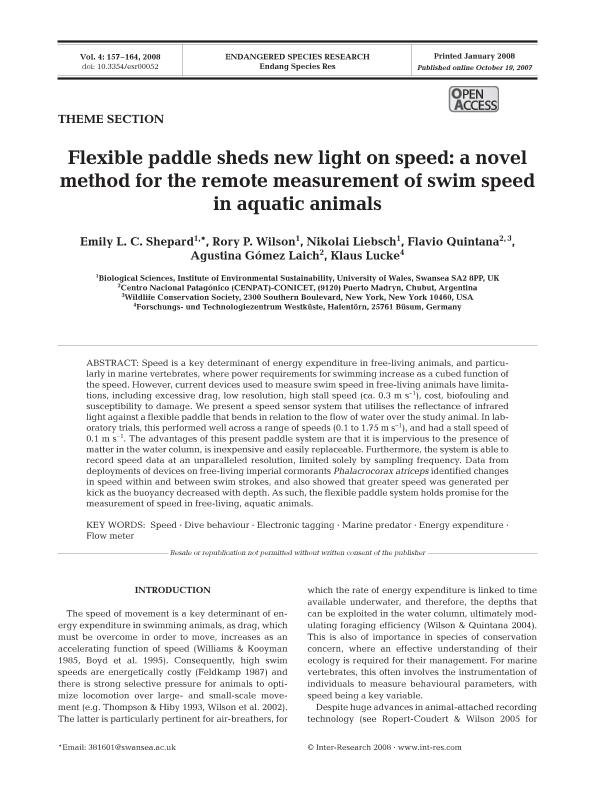Mostrar el registro sencillo del ítem
dc.contributor.author
Shepard, Emily L. C.
dc.contributor.author
Wilson, Rory P

dc.contributor.author
Liebsch, Nikolai
dc.contributor.author
Quintana, Flavio Roberto

dc.contributor.author
Gómez Laich, Agustina Marta

dc.contributor.author
Lucke, Klaus
dc.date.available
2020-03-26T17:24:54Z
dc.date.issued
2008-12
dc.identifier.citation
Shepard, Emily L. C.; Wilson, Rory P; Liebsch, Nikolai; Quintana, Flavio Roberto; Gómez Laich, Agustina Marta; et al.; Flexible paddle sheds new light on speed: A novel method for the remote measurement of swim speed in aquatic animals; Inter-Research Science Center; Endangered Species Research; 4; 1-2; 12-2008; 157-164
dc.identifier.issn
1863-5407
dc.identifier.uri
http://hdl.handle.net/11336/100938
dc.description.abstract
Speed is a key determinant of energy expenditure in free-living animals, and particularly in marine vertebrates, where power requirements for swimming increase as a cubed function of the speed. However, current devices used to measure swim speed in free-living animals have limitations, including excessive drag, low resolution, high stall speed. (ca. 0.3 m s-1), cost, biofouling and susceptibility to damage. We present a speed sensor system that utilises the reflectance of infrared light against a flexible paddle that bends in relation to the flow of water over the study animal. In labaratory trials, this performed well across a range of speeds (0.1 to 1.75 m s-1), and had a stall speed of 0.1 m s-1. The advantages of this present paddle system are that, it is impervious to the presence of matter in the water column, is inexpensive and easily replaceable. Furthermope, the system is able to record speed data at an unparalleled resolution, limited solely by sampling frequency. Data from deployments of devices on free-living imperial cormorants Phalacrocorax atriceps identified changes in speed within and between swim strokes, and also showed that greater speed was generated per kick as the buoyancy decreased with depth. As such, the flexible paddle system holds promise for the measurement of speed in free-living, aquatic animals.
dc.format
application/pdf
dc.language.iso
eng
dc.publisher
Inter-Research Science Center
dc.rights
info:eu-repo/semantics/openAccess
dc.rights.uri
https://creativecommons.org/licenses/by-nc-sa/2.5/ar/
dc.subject
DIVE BEHAVIOUR
dc.subject
ELECTRONIC TAGGING
dc.subject
ENERGY EXPENDITURE
dc.subject
FLOW METER
dc.subject
MARINE PREDATOR
dc.subject
SPEED
dc.subject.classification
Ecología

dc.subject.classification
Ciencias Biológicas

dc.subject.classification
CIENCIAS NATURALES Y EXACTAS

dc.title
Flexible paddle sheds new light on speed: A novel method for the remote measurement of swim speed in aquatic animals
dc.type
info:eu-repo/semantics/article
dc.type
info:ar-repo/semantics/artículo
dc.type
info:eu-repo/semantics/publishedVersion
dc.date.updated
2020-03-16T15:03:10Z
dc.identifier.eissn
1613-4796
dc.journal.volume
4
dc.journal.number
1-2
dc.journal.pagination
157-164
dc.journal.pais
Alemania

dc.description.fil
Fil: Shepard, Emily L. C.. University of Wales; Reino Unido
dc.description.fil
Fil: Wilson, Rory P. University of Wales; Reino Unido
dc.description.fil
Fil: Liebsch, Nikolai. University of Wales; Reino Unido
dc.description.fil
Fil: Quintana, Flavio Roberto. Wildlife Conservation Society; Estados Unidos. Consejo Nacional de Investigaciones Científicas y Técnicas. Centro Nacional Patagónico; Argentina
dc.description.fil
Fil: Gómez Laich, Agustina Marta. Consejo Nacional de Investigaciones Científicas y Técnicas. Centro Nacional Patagónico; Argentina
dc.description.fil
Fil: Lucke, Klaus. Forschungs und Technologiezentrum Westküste; Alemania
dc.journal.title
Endangered Species Research
dc.relation.alternativeid
info:eu-repo/semantics/altIdentifier/doi/http://dx.doi.org/10.3354/esr00052
dc.relation.alternativeid
info:eu-repo/semantics/altIdentifier/url/http://www.int-res.com/abstracts/esr/v4/n1-2/p157-164/
Archivos asociados
